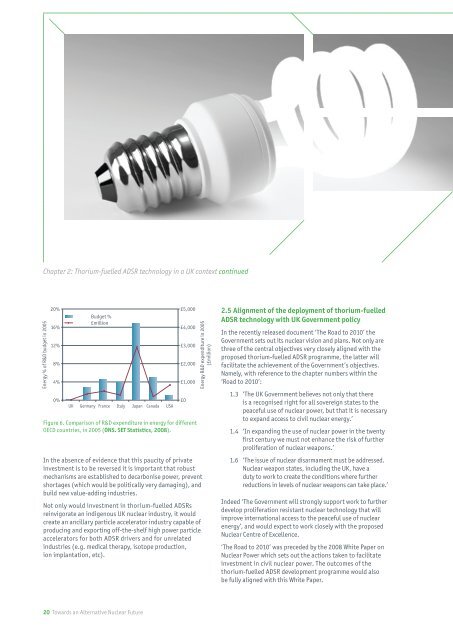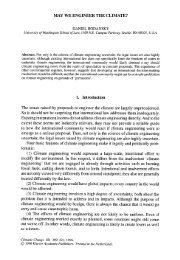ThorEA - Towards an Alternative Nuclear Future.pdf
ThorEA - Towards an Alternative Nuclear Future.pdf
ThorEA - Towards an Alternative Nuclear Future.pdf
You also want an ePaper? Increase the reach of your titles
YUMPU automatically turns print PDFs into web optimized ePapers that Google loves.
Chapter 2: Thorium-fuelled ADSR technology in a UK context continued<br />
Energy % of R&D budget in 2005<br />
20% £5,000<br />
16%<br />
Budget %<br />
£million<br />
£4,000<br />
12% £3,000<br />
8% £2,000<br />
4% £1,000<br />
0% £0<br />
UK Germ<strong>an</strong>y Fr<strong>an</strong>ce Italy Jap<strong>an</strong> C<strong>an</strong>ada USA<br />
Figure 6. Comparison of R&D expenditure in energy for different<br />
OECD countries, in 2005 (ONS. SET Statistics, 2008).<br />
In the absence of evidence that this paucity of private<br />
investment is to be reversed it is import<strong>an</strong>t that robust<br />
mech<strong>an</strong>isms are established to decarbonise power, prevent<br />
shortages (which would be politically very damaging), <strong>an</strong>d<br />
build new value-adding industries.<br />
Not only would investment in thorium-fuelled ADSRs<br />
reinvigorate <strong>an</strong> indigenous UK nuclear industry, it would<br />
create <strong>an</strong> <strong>an</strong>cillary particle accelerator industry capable of<br />
producing <strong>an</strong>d exporting off-the-shelf high power particle<br />
accelerators for both ADSR drivers <strong>an</strong>d for unrelated<br />
industries (e.g. medical therapy, isotope production,<br />
ion impl<strong>an</strong>tation, etc).<br />
20 <strong>Towards</strong> <strong>an</strong> <strong>Alternative</strong> <strong>Nuclear</strong> <strong>Future</strong><br />
Energy R&D expenditure in 2005<br />
(£million)<br />
2.5 Alignment of the deployment of thorium-fuelled<br />
ADSR technology with UK Government policy<br />
In the recently released document ‘The Road to 2010’ the<br />
Government sets out its nuclear vision <strong>an</strong>d pl<strong>an</strong>s. Not only are<br />
three of the central objectives very closely aligned with the<br />
proposed thorium-fuelled ADSR programme, the latter will<br />
facilitate the achievement of the Government’s objectives.<br />
Namely, with reference to the chapter numbers within the<br />
‘Road to 2010’:<br />
1.3 ‘The UK Government believes not only that there<br />
is a recognised right for all sovereign states to the<br />
peaceful use of nuclear power, but that it is necessary<br />
to exp<strong>an</strong>d access to civil nuclear energy.’<br />
1.4 ‘In exp<strong>an</strong>ding the use of nuclear power in the twenty<br />
first century we must not enh<strong>an</strong>ce the risk of further<br />
proliferation of nuclear weapons.’<br />
1.6 ‘The issue of nuclear disarmament must be addressed.<br />
<strong>Nuclear</strong> weapon states, including the UK, have a<br />
duty to work to create the conditions where further<br />
reductions in levels of nuclear weapons c<strong>an</strong> take place.’<br />
Indeed ‘The Government will strongly support work to further<br />
develop proliferation resist<strong>an</strong>t nuclear technology that will<br />
improve international access to the peaceful use of nuclear<br />
energy’, <strong>an</strong>d would expect to work closely with the proposed<br />
<strong>Nuclear</strong> Centre of Excellence.<br />
‘The Road to 2010’ was preceded by the 2008 White Paper on<br />
<strong>Nuclear</strong> Power which sets out the actions taken to facilitate<br />
investment in civil nuclear power. The outcomes of the<br />
thorium-fuelled ADSR development programme would also<br />
be fully aligned with this White Paper.



